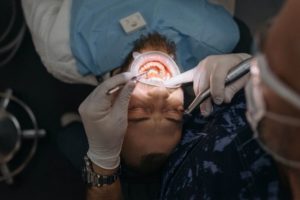The wisdom teeth, also called third molars, are the last teeth to grow … if they ever grow in! They differ in size and shape from one person to another. They are at the end of the jaw, behind the second molars. It is possible that one or more of these teeth never grow. Wisdom teeth usually appear at the end of adolescence, and their roots end up forming in the twenties.
Why wisdom teeth do not always grow
An adult person normally has 32 teeth (16 in the upper jaw and 16 in the lower jaw). However, often the space available on the jaw is not wide enough to allow the teeth to grow in properly.
In those cases, the wisdom tooth pushes against the crown of the second molar and gets stuck in the bone, without actually appearing. If the wisdom tooth remains stuck under the gums, it is said to be impacted. If it peaks out partially out of the gum, it is called semi-impacted. Sometimes it is possible that there is enough space in the jaw, but the tooth is tilted in such a way that its eruption is not possible. For example, a tooth that grows horizontally, or is inverted (in this case, roots grow out of the gum).
Why should wisdom teeth be removed?
There are several reasons why we need to remove wisdom teeth:
• In some people, wisdom teeth cause pain.
• The eruption of the wisdom teeth can cause the shifting of the other anterior teeth in the jaw, which then results in crooked teeth.
• In the case of orthodontic treatment where there is insufficient space on the dental arch, it is recommended to extract the wisdom teeth to allow proper alignment of the other teeth.
• Semi-erupted teeth are difficult to access and therefore cannot be cleaned properly. Bacteria and food debris are not removed properly by brushing can cause several problems, including dental caries.
• Wisdom teeth that grow horizontally can damage the root of the adjacent tooth (called resorption). If this tooth is too damaged, it must also be removed.
• Impacted and semi-impacted teeth can cause localized disease of the gums and bones surrounding the teeth.
• Impacted teeth increase the chances of developing a benign cyst or tumor.
• Pericoronitis (inflammation of tissues surrounding the crown of the tooth) and cellulitis (a facial soft tissue infection) are potential complications of impacted or semi-impacted wisdom teeth.
How are wisdom teeth extracted?
Extractions are performed at the dental clinic. The dental surgeon who performs this operation at the Centre de santé dentaire Dr. Thu Nguyen is an oral surgeon. He will first take X-rays to see the condition and position of the wisdom teeth. Then, he will plan the surgery according to the number of teeth to be extracted (4 at the same time or less).
Tooth extraction is usually done under local anesthesia. The gum is incised, then the practitioner extracts the tooth by removing it from the bone. It may sometimes be necessary to cut the tooth before extracting it. The gum is then sutured together with sutures that disappear by themselves within a few weeks. The practitioner will then give you instructions to ensure optimal healing.
The clinic also offers the possibility of extracting teeth under sedation with nitrous oxide (also called laughing gas). This is a safe procedure that allows our anxious patients to relax during a dental treatment. We invite you to read the full article on that subject.
If you feel that you need to extract your wisdom teeth, make an appointment now at Centre de santé dentaire Dr. Thu Nguyen. Our oral surgeon will make a proper diagnosis and will guide you throughout the treatment.
Make an appointment
[contact-form-7 id= »18559″ title= »Appointment form »]





